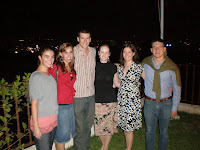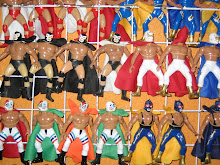
It was Friday afternoon, during peak traffic hours, and I had a three hour car ride from the airport in Barcelona, Venezuela, to Cumana. Faced by sweltering heat, I was to make the trip in a staple of Venezuelan public transportation: the buseta. This name belongs to a class of oversized vans that –crammed with passengers– travel local routes among cities and towns. Preceding the schlep, I had arrived in Barcelona by plane from Caracas, where I had attended a meeting on Thursday at the U.S. Embassy with other Fulbright English Teaching Assistants (ETAs) and the embassy staff. Following our meeting, an embassy contracted van took us to an evening jazz recital at the ambassador’s house. The meeting was successful, and it was a pleasure to enjoy the recital with the other ETAs. However, the subject that calls my attention most is neither the meeting nor the recital. Rather, I am fascinated by the contrast between the embassy van and the buseta, for their dichotomy reveals the extremes that I have encountered in my experience in a provincial region of Venezuela yet under the auspices of the U.S. government.
It would be a grave understatement to call the buseta “secondhand” given its many defects. The windshield was cracked, the speedometer was broken, and the air conditioning did not work. Fortunately, the absence of the buseta´s rear door aided air circulation in the car; the gaping hole in the vehicle´s side abated the merciless heat. My favorite feature would be the splintered ply wood panel that covered the left side, contrasting the dull, unfinished paint job of the van´s shell. Though U.S. made and built during the mid-1980s, the vehicle had shed its North American identity as salsa music blasted from oversized speakers. My buseta was loaded with its own sabor.
Despite these critical observations, I am not picky when it comes to public transportation, even if it means braving a three hour ride to my destination in a buseta. And I was simply on my way back to my clean yet nondescript home in Cumaná, a small city that has more attributes of a large town than a metropolitan city. It is unassuming and low-key, for the most part.
The aesthetic qualities and destination of the embassy van was a 180° flip. The vehicle’s immaculate, white exterior reflected the neon lights of Caracas as Cesar, the driver, picked the ETAs up at the hotel. It was about 6:30 in the evening when we moved from the air-conditioned hotel lobby to the air conditioned van; there was not a bead of sweat on my brow as I opened the door and hopped into my well-upholstered seat. The door closed, and Cesar drove us through Caracas traffic. However, the fully enclosed vehicle muffled the din of the city as Cesar refrained from playing salsa music at a blaring volume. Our artificial sanctuary-on-wheels headed to the jazz recital.
The destination of the embassy van was the opposite of nondescript: we were to enjoy an evening of jazz in the home of the U.S. ambassador to Venezuela*. The large house lies in an exclusive neighborhood on the slope of a mountain that overlooks Caracas. The fine backdrop complemented the even finer hors d'oeuvres, whiskey, rum and wine served to the embassy employees in attendance. No one constituted royalty, yet this event was aristocratic relative to most social affairs that I had attended in Venezuela. The jazz saxophonist Pablo Gil played his set, and by 9:30 we were heading towards the white embassy van to go back to our hotel. I enjoyed the whole ordeal yet felt surprised that the event was sponsored by the U.S. government.
I ask myself: figuratively speaking, do I prefer the buseta or the embassy van? The most gratifying choice is not obvious to me. The buseta was cramped and not aesthetically pleasing, yet it felt dynamic and exciting; the soundtrack conjured up a desire to dance to the rhythms in my seat. The embassy van was clean, comfortable and free of inconveniences. On the downside, the ride raised neither my heartbeat nor my adrenaline. The buseta took me to Cumaná, the low-key Venezuelan city where I strictly rub elbows with Venezuelans. The embassy van took me to the crème de la crème of the capital where I rubbed elbows with my compatriots. The dichotomy distilled: down-to-earth, corybantic, 100% Venezuela versus U.S. privilege, transplanted to the Caribbean and doused in the finest of Venezuelan rum. Who am I kidding? I want both.
*Note: Technically the U.S. ambassador to Venezuela was designated persona non grata by President Hugo Chávez. In place of the ambassador, the chargé d'affaires carries out the ambassador’s duties.



